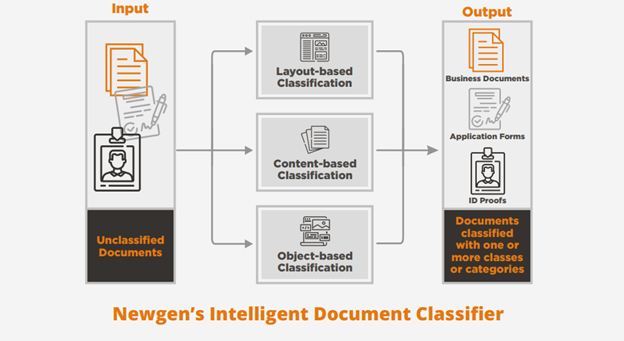As the name suggests, content classification classifies structured, semi-structured, and unstructured documents based on layout, content, and object-based type.
Incoming documents come in various types, including application forms, claim forms, invoices, identity proofs, etc. In a manual setup, employees are required to open documents, skim through them, and classify them, which is not a very effective technique. Here’s when an intelligent content classifier software comes into the picture. It enables enterprises to classify documents and organize information quickly and easily. It provides valuable information that can be leveraged to understand the trend and gain meaningful insights.
What are the facilitators for intelligent content classification?
- Artificial Intelligence (AI)
- Machine learning (ML)
Do you know the benefits of content classification?
- Improves customer experience
- Reduces service and operational costs
- Eases integration with core business applications
- Automates bulk documents classification
- Facilitates adherence to regulatory compliance
- Intelligent decision making
How can content classification solution be implemented?

Layout-based classification
It classifies documents by determining the physical layout of the document against pre-trained layouts.
Content-based classification
It reads the content from semi-structured and unstructured documents, matches them to stored keywords, and identifies the correct classifier accordingly
Object-based classification
It reads the various images, logos, etc., on a document and matches pre-determined patterns like recognizing a driving license.
What are the capabilities of Content Classification?
- Assigning each document to a class based on the content and visual classification
- Model training studio to learn about new content types for classification and metadata extraction
- Easily integrate with core business applications, content management platforms, and document capture applications
- Auto segregation capability to automatically identify the first and last pages in batch documents
- Capability to import a large volume of documents and assign classes to each document
- Robust document classification capability – Irrespective of language, OCR quality, color depth, skewed layout
- Multilingual document classification – Irrespective of the language used in the document, a trained model of content-based classifier classifies the documents
Key-takeaways
Content classification system simplifies document management, reduces operational costs, and increases employees’ productivity. Content classification software is an essential capability of contextual content service platforms.
Newgen has been recognized in the Gartner® Magic Quadrant™ for Content Services Platforms. Are your documents slowing you down? Read this eBook to know how a contextual content service platform can help you streamline your documents and ensure business continuity.
You might be interested in



25 Sep, 2025
Transforming Enterprises with Newgen’s Business Process Management Software

